Qualcomm has long been a foundational force in setting the standard for mobile computing, and its foray into the PC market with the Snapdragon X Series has been anything but conventional. The goal was never to simply match existing PC processors, but to fundamentally redefine the laptop experience by prioritising efficiency and connectivity—the twin pillars that define the modern computing workflow. The Snapdragon X Series represents the company’s most direct challenge yet to the incumbent x86 architecture, promising to unlock thinner designs, always-on connectivity, and battery life measured in days, not hours.
Now, Qualcomm has officially announced the next step in this evolution: the Snapdragon X2 Elite. Positioned as the engine for premium Windows 11 PCs, this platform is engineered for powerful, efficient multitasking across the resource-intensive workloads that define productivity, creativity, and entertainment today. The message is clear and direct: the X2 Elite intends to deliver industry-leading performance that can truly last for days, even in thin and light devices.

Performance That Lasts for Days
The cornerstone of the X2 Elite’s performance claim is a singular focus on power efficiency. The processor is built on the cutting-edge 3nm process node, a crucial technical detail that translates directly to a cooler, faster, and longer-lasting user experience. This advanced node technology allows the platform to achieve impressive performance gains—up to 31% faster performance at ISO power—while demanding significantly less energy, requiring up to 43% less power than its previous generation counterpart. For the average user, this isn’t just a spec bump; it means genuinely working all day, or even for multiple days, without being tethered to a power outlet.
The central processing unit at the heart of the platform is the 3rd Gen Qualcomm Oryon CPU. The Snapdragon X2 Elite (specifically the X2E-80-100 SKU) features a total of 12 cores, intelligently split between performance and efficiency, a standard practice for balancing workloads. This configuration includes six Prime Cores and six Performance Cores. The Prime Cores offer a maximum multi-core frequency of 4.0 GHz, with the capability to boost up to 4.7 GHz in single-core loads. The accompanying Performance Cores run at a brisk 3.4 GHz. This core architecture, paired with a substantial 34 MB of total cache, ensures that resource-intensive applications run smoothly and quickly, making effortless multitasking a reality.
80 TOPS of Hexagon NPU Power for AI Workloads
If efficiency is the foundation, artificial intelligence is the future, and Qualcomm is taking a decisive lead here. The Snapdragon X2 Elite platform is a fully-fledged Copilot+ PC engine, built to handle the intense concurrent AI experiences now hitting the Windows environment
The platform features the Qualcomm Hexagon NPU with a massive 80 TOPS (Tera Operations Per Second) of AI processing power. This raw number is significant, positioning it as one of the world’s fastest NPUs for laptops. This leap in AI hardware is critical for enabling the next generation of applications, including on-device AI agents, multimodal content generation, and media editing acceleration. The 80 TOPS NPU operates with a 64-bit architecture and increased memory access, providing the bandwidth necessary to run the latest large language models (LLMs) with blazing responsiveness and minimal latency.
Graphics, Memory, and Unrivaled Connectivity
For graphics performance, the Snapdragon X2 Elite features an upgraded Qualcomm Adreno GPU. This new architecture is designed not only for stunning visuals but for industry-leading performance per watt, meaning creators and casual gamers can maintain frame rates and image quality while working off the battery. The GPU supports modern standards like DirectX 12.2 Ultimate, Vulkan 1.4, and OpenCL 3.0.
Memory and storage are equally aggressive in their pursuit of speed. The platform supports LPDDR5x memory with a transfer rate of 9523 MT/s and a bandwidth of 152 GB/s. For storage, it supports both NVMe via dual PCIe 5.0 and the latest UFS 4.0 standard. This ensures that data access is never a bottleneck, whether launching a massive game or loading an intricate media project.

When it comes to connectivity, the platform supports up to the Snapdragon X75 5G Modem-RF System, enabling lightning-fast cellular connections with peak download speeds of up to 10 Gbps. On the Wi-Fi front, it integrates the Qualcomm FastConnect 7800 System, bringing support for Wi-Fi 7 with High Band Simultaneous (HBS) and peak speeds of 5.8 Gbps, alongside advanced Bluetooth 5.4 LE audio. This advanced connectivity means the promise of a truly mobile, always-on PC is finally fulfilled.
Multimedia and Security
The X2 Elite is a platform built for the entire computing experience, including professional multimedia work and robust security. The Qualcomm Adreno VPU (Video Processing Unit) is capable of encoding and decoding video up to 8K at 60 FPS, a crucial detail for content creators working with high-resolution footage. Furthermore, the platform can drive the display across a complex setup, supporting up to three external displays at resolutions up to 5K at 60 Hz or 4K at 144 Hz. The Qualcomm Spectra ISP (Image Signal Processor) delivers dual 18-bit processing for crystal-clear web conferencing and photo capture, ensuring professional image quality in any light.
Finally, security is handled from the ground up. The X2 Elite features the advanced Qualcomm SPU, which supports Microsoft Pluton, providing state-of-the-art security from the chip to the cloud. For IT management and end-user peace of mind, the new Snapdragon Guardian Technology introduces out-of-band management, allowing businesses and users to remotely manage, find, lock, and wipe their PC from virtually anywhere via Wi-Fi and 5G.
The Snapdragon X2 Elite, with its combination of a power-sipping 3nm process, the mighty 80 TOPS NPU, and multi-day battery life, is set to redefine the Windows PC category, enabling the kind of intelligent, always-connected experiences consumers have been demanding. Devices powered by this new platform are expected to be available in the first half of 2026.





